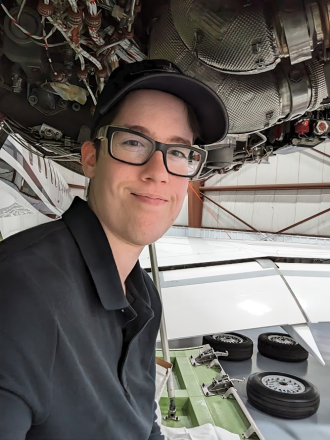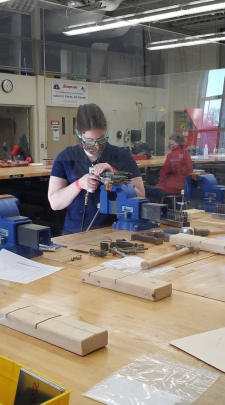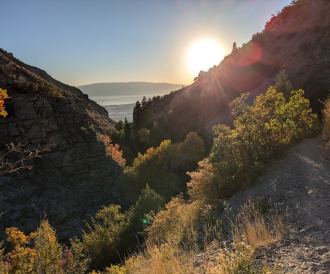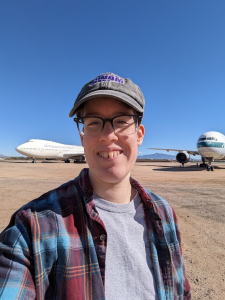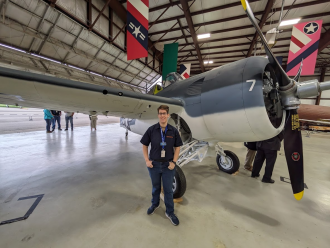Wrenches and Wings: Morgan Boyd’s Mission to Keep Aviation Soaring
Inside Morgan Boyd beats the heart and soul of a true mechanic.
Read her words: "I have found that there is nothing more thrilling than watching an aircraft, which you helped tear apart, inspect, fix and then reassemble, again take off from the runway and fly home."
While the WMU College of Aviation attracts students, faculty and staff from all over the country -- and the globe -- Boyd basically stepped into her backyard to prep for a career in aviation technical operations.
A near-lifetime resident of Kalamazoo, Western's home campus in southwest Michigan, Boyd is a 2020 graduate of Kalamazoo Central High School. "I had the pleasure of having WMU right in my backyard and was able to be immersed in the university before ever stepping foot on campus as a student," she says. "I knew about the professors and the programs, and how exceptional they were. It became very clear that there was a reason that the Western aviation program was typically ranked at the top."
A degree recipient in December of 2023, she believes she blossomed in the engine-overhaul course. "I was able to tear an engine completely apart," she says, "and put it back together again. I find this is where I learn the best. I am able to understand a system better when I'm able to see how it all goes together."
But why aviation, and not becoming a Ms. Goodwrench in automotive mechanics? "My father was in the Air Force when I was young, so aviation was always around me. My parents made a point of exposing me to a multitude of career fields and encouraged me to follow my interests."
Trips to the Air Zoo Aerospace Museum in Kalamazoo piqued one particular interest, which was amplified by her participation in the community's Education for Employment program in aviation science. "That's where I learned about careers in aviation outside of being a pilot," she says, "and where I truly fell in love with aviation maintenance through a series of hands-on projects."
The innate talent she brought with her to WMU was cultivated and nourished by College of Aviation instructors Nate Lisak, Jeremy Hierholzer and Mark Matteson. But at the top of Boyd's list is assistant professor Gail Rouscher. "Dr. Gail continues to be an amazing mentor who has pushed me to be the best mechanic and person that I can be. I don't think I'd be where I am today without her. She pushed me to step outside of my comfort zone, to learn more skills, and reach for opportunities outside of the classroom."
That "push" took her to student organizations, such as the Association for Women in Aviation Maintenance where she served as chapter president, the Skills USA competition, Women in Aviation International, and Western's Aviation Student Council. Boyd says each helped in both her student and now her professional life through scholarships and training opportunities. Skills were honed and networking connections made, all of which have been invaluable to her advancement.
Rouscher has served as a faculty adviser for these organizations, which fostered further connections with Boyd. "She has always been a strong advocate for women in the field," Boyd says. "Because I was often the only woman in my courses for a majority of my college career, she made sure I was supported and even checked in with me when I wasn't enrolled in her courses."
A summer internship after her sophomore year took her to the airframe division of Duncan Aviation, located just down the runway from the college's base at the Battle Creek Executive Airport at Kellogg Field. The following summer found her interning at Stryker Corporation's flight department. Graduation saw Boyd returning to Duncan's airframe department as a full-time technician armed with an A&P (airframe and powerplant) certificate.
For Boyd, the A&P certificate is more than an indicator of one's mechanical knowledge. "It really is a license to learn," she says, and that is indicative of the challenges she faces. "There is truly so much to learn and remember. Sometimes it feels as though you are drinking out of a firehose with all of the information you have to ingest in a constantly changing industry. You have to be quick to adapt."
She believes that path of speedy adaptation will take her to becoming an even more-skilled aviation mechanic with the long-term goal of moving into a management position, and someday being the director of maintenance for an enterprise's flight department.
But until then, she relishes what she is doing. "Every day is different," Boyd says. "I'm not sitting behind a desk in an office with no windows. I get to be on my feet, in and around airplanes, on and off the ramp. Because no day is the same, it's fresh and exciting. There is always something new to learn."
Boyd has not forgotten where she has come from. "In giving something back to Western's program," she says, "we can prepare the next technicians, pilots, and management that will keep our industry safe and vibrant. I find it incredibly important to support and uplift women in the industry as we continue to grow our numbers, which have grown exponentially in the tech-ops classes since I was there."
When there are events such as the Women in Aviation's "Girls in Aviation Day," career symposiums, or creating projects designed to promote being a mechanic as a professional life for females, Boyd is a willing participant who can also chronicle the amazing experiences that can come a person's way by being involved in the aviation industry.
Some of those involve travel to far away places with strange-sounding names. But they can also be closer to home, such as Boyd's continuing connection with the Air Zoo as a volunteer restorer. She was part of the team that brought back to life fighter planes that had spent the last 70 years or so at the bottom of Lake Michigan.
That's where the bulk of the training for pilots assigned to aircraft carriers took place as the United States beefed up its capabilities for aerial combat against the Japanese in World War II. More than a few pilots crashed into the water and died during these training exercises. Boyd's team restored a Douglas SBD Dauntless dive bomber, which was the prime carrier-based plane in the Pacific, and a Grumman FM-2 Wildcat, a souped-up version of the original FM-4.
''This has been an incredibly rewarding experience," she says, "by being able to use the skills that I have developed to fix a piece of history. This part of aviation has really been a labor of love, and helps keep my passion for airplanes alive."
How's that for a career pitch!


